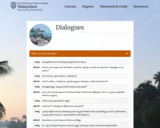
Malayalam dialogue useful for everyday life.
- Subject:
- Arts and Humanities
- Languages
- Material Type:
- Module
- Provider:
- University of Texas at Austin
- Provider Set:
- COERLL
- Author:
- Aaron Sherraden
- Darsana Manayathu Sasi
- Date Added:
- 12/10/2021

Malayalam dialogue useful for everyday life.

This online dictionary, entirely in Arabic, gives Arabic synonyms and antonyms of words entered into the dictionary, helping to expand the vocabulary of anyone using it. It also gives rhyming words for those interested in writing poetry or for any other reason one might need a rhyming word. The broken plurals of words are also displayed.
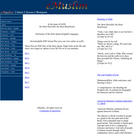
This Arabic-English dictionary of the Qur'an is not compiled in the traditional, alphabetical way, but rather by chapter and word order in the Qur'an. The list is available both for viewing online as well as via downloadable PDF documents. Prepositions and attached pronouns are included in the list alongside full words. The word list doesn't include every single word in a particular verse if that word has been mentioned before, i.e. ____ is only listed once in the Surat al-Fatiha vocabulary despite being in the chapter twice. Roots of longer words are frequently given.
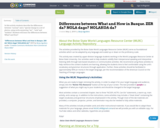
In this activity students describe the differences between “normal” and a “special change in a set of photos, using verbs answering “zer”, “nola" and "nolakoa". Students will learn the differences between What? and How?
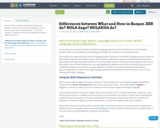
In this activity students describe the differences between “normal” and a “special change in a set of photos, using verbs answering “zer”, “nola" and "nolakoa". Students will learn the differences between What? and How?
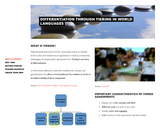
This site explains how teachers can tier activities in their World Language classrooms. It includes background information about tiering, steps for teachers to develop tiered activities, and examples of tiered activities.

In 1999, the University of Chicago began the Digital Dictionaries of South Asia (DDSA) to make electronic dictionaries of South Asian languages available to the public for free. It includes languages from Afghanistan, Bangladesh, Bhutan, India, the Maldives, Nepal, Pakistan, and Sri Lanka. Gary Tubb, Professor and Chair of the Department of South Asian Languages and Civilizations (SALC), and James Nye, former University of Chicago Library Southern Asia bibliographer and COSAS Emeritus, were awarded a grant from the U.S. Department of Education that allows them to expand these digital dictionaries to include Kashmiri, Panjabi, Persian, Sindhi, Sinhala, Telugu, and Urdu languages. James Nye is a CAORC Multi-Country Research Fellowship alum, who traveled to Sri Lanka, Maldives, Nepal, and India on the fellowship.

Cultural heritage has a crucial role to play in education, and we want to bring this source of knowledge to every learner, educator and educational organisation. One of the ways that we do this is through Europeana’s Education MOOCs - or Massive Online Open Courses - which allow large numbers of participants to learn new skills and develop their knowledge through online teaching. The online course will explore the educational potential of digital cultural heritage to support teachers and educators to efficiently integrate it into their lessons and practices, regardless of the subject they teach. The final goal is to design engaging content for students, museumgoers and lifelong learners to prepare them as active and responsible citizens and to thrive. Register now: https://www.europeanschoolnetacademy.eu/courses/course-v1:Europeana+Culture_EN+2022/about
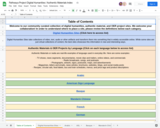
Welcome to our community curated collection of digital humanities, authentic material, and OER project sites. We welcome your collaboration! In order to understand where to place a site, please review the definitions below each category.
Digital Humanities Sites take collections of video, text, audio or other artifacts and transform them into something that is widely accessible online. While some sites are just virtual collections of content, the best sites showcase this information in new and interesting ways.
Authentic Materials or realia are real-life examples of language used in everyday life. Here are some examples:
- TV shows, news segments, documentaries, movie clips and trailers, online videos, and commercials
- Radio broadcasts, songs, and podcasts
- Photographs, artwork, signs, postcards, maps, and advertisements
- Magazines, letters and emails, news articles, brochures, websites, blogs, and social media posts
- Recipes, circular ads, food labels, bus and train schedules, menus, and price tags and product descriptions
"

Would you like to incorporate interactive sites, commercials, artwork, menus, social media posts, and more into your world language classroom? In this one hour webinar, we’ll highlight some of our favorite digital humanities and authentic resources sites full of engaging materials to spark student’s curiosity and immerse them in the target culture. We’ll also share some of our strategies for finding these sites, including a searchable, community-built repository!
Slides: https://docs.google.com/presentation/...
Click Here! Guide: https://simplebooklet.com/clickhere#p...
Contribute a Site: https://docs.google.com/forms/d/e/1FA...
Connect with the Pathways Project on Social Media:
- Instagram: https://www.instagram.com/boisestatep...
- LinkedIN: https://www.linkedin.com/groups/9178362/
- Twitter: https://twitter.com/PathwaysBSU
Digital Humanities & Authentic Materials by Kelly Arispe and Amber Hoye is licensed under a Creative Commons Attribution-NonCommercial-ShareAlike 4.0 International License.
http://creativecommons.org/licenses/b...
Acknowledgement
The Pathways Project is grateful to provide this professional development opportunity thanks to a recently awarded National Endowment for the Humanities Digital Humanities Advancement Grant.
About the National Endowment for the Humanities
Created in 1965 as an independent federal agency, the National Endowment for the Humanities supports research and learning in history, literature, philosophy, and other areas of the humanities by funding selected, peer-reviewed proposals from around the nation. Additional information about the National Endowment for the Humanities and its grant programs is available at: http://www.neh.gov
License
Creative Commons Attribution license (reuse allowed)
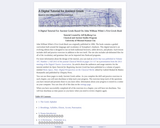
John William White's First Greek Book was originally published in 1896. The book contains a guided curriculum built around the language and vocabulary of Xenophon’s Anabasis. This digital tutorial is an evolving edition that is designed to run on both traditional browsers, tablet devices, and phones. Each lesson includes drill and practice exercises in addition to the text itself. The site also includes tab-delimited files for all of the vocabulary and grammar that can be imported into flashcard programs.
For more information about the design of the tutorial, you can read an article that was published in Volume 107, Number 1, Fall 2013 of the journal Classical World on pages 111-117 or a presentation from the 2013 meeting of the Digital Classics Association. An article about the audiences and usage statistics for the tutorial entitled An Open Tutorial for Beginning Ancient Greek has been published in a volume of papers entitled Word, Space, Time: Digital Perspectives on the Classical World. edited by Gabriel Bodard & Matteo Romanello and published by Ubiquity Press.
You can use these pages to study Ancient Greek online. As you complete the drill and practice exercises in each chapter, you will earn drachmas to help track your progress. The exercises keep track of the questions you have missed and presents those to you more often. Information about your progress is stored in a cookie on your computer. You can clear all of this data on the settings page.
When you have successfully completed all of the exercises in a chapter, you will have ten drachmas. You will lose drachmas as time passes so you know when you need to review chapters again.
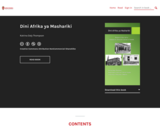
This module is designed to help learners of Swahili as a foreign language achieve Advanced Low proficiency on the ACTFL scale. For classroom learners, it is most appropriate for students who have already studied Swahili for two or three academic years, while self-directed learners and/or those who have spent a significant amount of time in East Africa may find it useful at earlier or later stages of study.
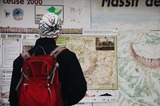
Students will be able to practice translating written English to ASL with a focus on directional verbs and classifiers in storytelling.

Students will be able to practice translating written English to ASL with a focus on directional verbs and classifiers in storytelling.
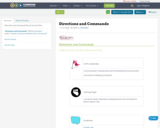
Directions and Commands
Places Around Town

Long Description:
Discourse Community for Future Business Leaders is meant to help improve student learning outcomes in writing for business students across post-secondary institutions by exposing them to discourse community, and the importance of understanding lexis and its use in effective business communication. It is an interactive tool for connecting discourse to collegiate writing, that can be used in the classroom and beyond, and can greatly improve student outcomes through this self-directed study.
This text lends itself to improved business expository writing (succinct sentence structure, compelling thesis statements, persuasive arguments, passive vs. active voice, appropriate lexis, and jargon) and is designed as a supplemental OER for business students in composition and research courses. It fills a void in the high-need area of business composition that will increase writing achievement for collegiate business students.
Word Count: 1768
Included H5P activities: 10
(Note: This resource's metadata has been created automatically by reformatting and/or combining the information that the author initially provided as part of a bulk import process.)

Television networks and newspapers do a good job of sharing the aftermath of natural disasters with the world. They discuss the injuries that occur within the people as well as who the heroes are in helping those injured. In this seminar you will listen and read about true heroes as they discuss injuries and what they went through.ACTFL StandardsCommunication: Interpersonal Communication, Presentational CommunicationConnections: Making ConnectionsCommunities: School and Global CommunitiesLearning TargetI can explain an injury and manage to get help.Habits of MindListening with understanding and empathyCritical Thinking SkillInvestigation
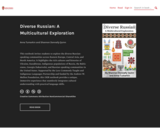
This textbook invites students to explore the diverse Russian-speaking communities across Eastern Europe, Central Asia, and North America. It highlights the rich cultures and histories of Ukraine, Kazakhstan, Indigenous populations of Russia, the Baltic states, Georgia (Sakartvelo), and Russian-speaking communities in the United States. Supported by the Less Commonly Taught and Indigenous Languages Partnership and funded by the Andrew W. Mellon Foundation, this OER textbook provides a unique, immersive experience that seamlessly integrates cultural understanding with practical language skills.
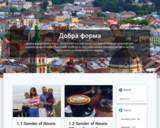
Dobra forma (Good Form) provides a web-based overview of Ukrainian grammar with contextualized activities that enable students to internalize correct grammatical forms as they focus on the communication of meaning. This approach recognizes that students need to see, hear, and process a target structure in context multiple times before they can reliably produce it themselves. The modules begin with activities that encourage students to comprehend what is said or written before they focus on how the target structure encodes that meaning; and only after these crucial, initial steps will the students proceed to activities in which they produce the target structures themselves. Known in Second Language Studies as structured input and structured output, these activities will enable students to gain an implicit knowledge of grammar that will increase their ability to interpret new structures.